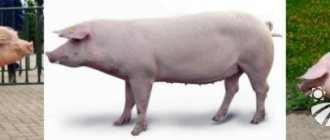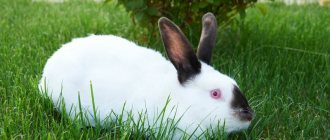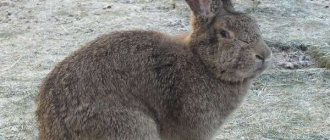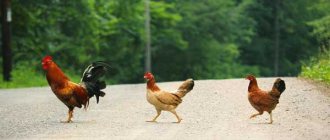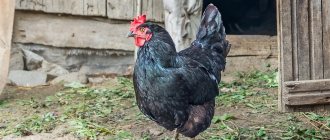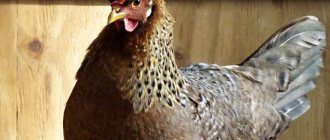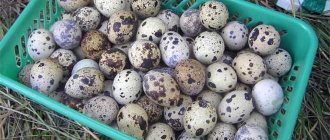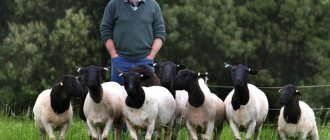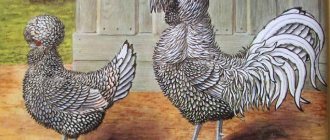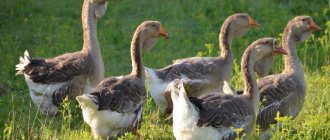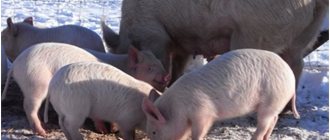Rabbit breeding in the USSR began to actively develop in the second half of the 1920s, when thousands of rabbits of various breeds were brought from Europe to the western regions of the country (mainly Ukraine and Belarus, as well as the western regions of the RSFSR) for breeding on collective and state farms. This branch of the Soviet economy experienced a series of ups and downs, but in the end, the undoubted success of Soviet rabbit breeders was the emergence of several highly productive breeds. Among them is the famous silver giant rabbit.
Rabbits Poltava silver: description, characteristics, breeding and maintenance of the breed
Rabbits of the Poltava Silver breed have a unique fur color, excellent meat yield, and resistance to severe frosts.
That is why the breed became widespread in regions with cold winters in the last century.
Today, the livestock of this breed is not so numerous, however, many are domestic for meat and valuable fur.
Rabbit of the Poltava Serebro breed
Origin
The Poltava Serebro (Soviet Serebro) breed was bred by Soviet breeders in the middle of the last century. The Champagne breed, which was distinguished by its unique silvery fur color, was taken as the basis for breeding work. These animals came to Europe back in the 15th-16th centuries, and were brought into the USSR from Germany and were poorly adapted to the harsh climate.
Poltava Serebro rabbits were officially registered by Soviet breeders in 1952. Specialists from the Ukrainian nursery “Petrovsky” have been working on the selection for many years. As a result of crossing with local breeds, French rabbits were able to increase their average body weight and increase their resistance to frost.
Description and characteristics
The peculiarity of the Poltava Silver breed is its spectacular silver color, which is obtained by a combination of 3 shades: smoky blue undercoat, white guard hairs and black guides.
The body is lighter in color compared to the head, paws and tail. The wool of rabbits of this breed is rollback, characterized by increased density and high elasticity.
Due to this, the animals always look neat and tidy.
Reference. Rabbits have an unusual silver coat color due to the presence of the SI gene. It is noteworthy that with age, it becomes lighter due to an increase in the number of white fibers in the fur. Outwardly, it looks as if the rabbit is turning grey.
Main characteristics of the breed:
- Strong, proportional physique with well-developed muscles.
- The back of the body is curved in the shape of an arch, the back is flat.
- The rabbit's body length is from 54 to 57 cm.
- The average weight of an individual is 6 kg.
- The ears stick out vertically.
Appearance of a rabbit of the Poltava Serebro breed
Animals of this silver breed are kind. They have a non-aggressive character and a balanced psyche. Their calm demeanor and good nature make them suitable for home cultivation.
Pros and cons of the breed
The Poltava Silver breed is a meat-skin breed. Such rabbits give a very high meat yield: up to 65% of live weight. Because of such indicators, a slightly forgotten breed is beginning to gain popularity again.
The fur of this rabbit is also highly prized. Its unique color allows you to create original models of outerwear and accessories, so breeders do not have any problems selling the skins of such rabbits.
The disadvantages of the breed include poor adaptation to extreme heat. That is why the silver rabbit is practically not common in the southern regions of Russia. This breed also requires careful control of indoor humidity: with excess moisture, rabbits look depressed and become prone to various diseases.
Feeding
Silver rabbits do not have any special dietary requirements. They eat grains, legumes, vegetables, fruits, greens in the form of fresh grass and branches, and hay.
To quickly gain weight, you can use industrial feed, which is produced with increased nutritional value, as the basis of nutrition.
Domestication of young animals to mixed feed is carried out gradually in order to avoid problems with the digestive tract.
Feeding recommendations from experienced breeders:
- fresh grass or hay should be fed to rabbits daily, as this ensures normal digestion of food;
- branches and wooden sticks, constantly kept in the cage, ensure uniform grinding of teeth;
- You should avoid a large proportion of grains in the diet of rabbits, as this leads to obesity, decreased meat quality and decreased fertility;
- Rabbits of this breed eat well mash prepared from boiled vegetables with the addition of meat and bone meal and vitamin complexes.
In order for rabbits to digest food well and be healthy, it is necessary to carefully monitor the quality of food and the cleanliness of feeders. Do not give food with signs of rotting and mold, wet grass and hay. Rabbits should have unlimited access to clean drinking water: it is necessary to monitor the fullness and cleanliness of the drinking bowls 2 times a day.
How to breed the breed correctly
Silver rabbits have high rates of early maturity. Females reach puberty at 4 months. If they weigh more than 2.5 kilograms, rabbits can be mated.
The time interval between hunts in rodents is 8 days. The duration of the hunt is 3-5 days. Adult females can become pregnant 4-5 times in 1 year. If we talk about males, then one male fertilizes 6-8 rabbits per year.
According to experienced rabbit breeders, it is not recommended to mate rabbits that are too thin or fat: this can harm the offspring. Average fatness of 2.5-3 kg is considered ideal for mating.
The offspring of Poltava silver rodents are born within a month. On average, 7-9 rabbits are born. After giving birth, the female rabbit can be allowed to mate again.
The cubs are born black. Their weight does not reach 75 grams. “Silver” glimpses in babies begin to appear after about 30 days.
Gradually the head, back and ears begin to turn silver, then the chest. Babies grow very quickly. After two months, the rabbits weigh 2 kilograms, after four months - already 4 kilograms. At this age, the color takes on characteristic features.
Care and maintenance
Poltava silver rabbits are undemanding in terms of living conditions. They feel great in temperate climates and, despite having a thick coat, do not tolerate severe frosts. Therefore, in winter, the home of silver rabbits is additionally insulated.
For keeping Poltava Silver rabbits, spacious enclosures or cages are suitable, inside of which there is a feeder, a drinking bowl and bedding made of hay or straw. The room should have both natural and artificial lighting. It is recommended to place cages with animals away from drafts, direct sunlight and heating appliances. It is advisable to constantly keep them clean and treat them weekly with disinfectants or a blowtorch.
Silver rabbits quickly become accustomed to people and can be kept as pets. In this case, they are housed in large cages with a removable tray, heavy bowls for water and food, and a tray for going to the toilet.
How to properly keep silver rabbits
One of the undeniable advantages of Soviet Silver rabbits is their ability to survive in almost any climatic conditions. A temperature of +20 degrees is ideal for such pets.
It should be noted that the animals also survive with ease in hot weather, although they do not like such weather conditions. As a result, during the hot season it is recommended to shade the cages in which animals are kept.
The optimal place for raising silver rabbits is central Russia. At the moment, silver giants have become widespread almost everywhere. Breeding and raising representatives of this breed of rabbits is quite simple, so any breeder, even a beginner, can do it.
The main requirement is the correct choice of location for the placement of cages with animals, as well as compliance with the following requirements:
- When choosing a place where cages will be installed for future pets, it is better to give preference to an area protected from strong winds and drafts.
- In order to protect from the scorching summer sun, the animals need shade and good ventilation, so it may be necessary to install additional awnings.
- Silver rabbits develop better and gain body weight when kept in spacious cages where cleaning is carried out in a timely manner.
- Pets of the silver breed are quite unpretentious animals in terms of care. However, during the cold season it is recommended to keep them in a warmer place.
- An important condition when breeding silver rabbits is the weekly sanitary disinfection of the cage, as well as containers for food and drink.
- Do not leave uneaten food in the feeder.
- We should not forget about timely vaccination of pets. Representatives of this breed are quite resistant to numerous diseases. However, in order to prevent myxomatosis and other dangerous diseases, it is necessary to give the animals appropriate vaccinations.
Silver rabbits do not require special care, although they do need basic conditions to thrive.
Description and characteristics of the breed
Appearance and standard of the subspecies
The weight of individuals reaches 3-4.5 kg. They have an elegant constitution and thin aristocratic bones. The head is elongated, the paws are small, the ears are medium in size. Rabbits reach a length of 40-54 cm. Babies at the age of 30 days weigh no more than 650 grams. At the age of 60 days, the weight reaches 680 g. 90-100 rabbits weigh 2.1 kg from birth. At the age of 120-130 days, their weight is 2.3-2.4 kg.
The animal's fur is short-haired, reaching no more than 2 cm. The hair is soft, pleasant to the touch and very thick (see photo).
A distinctive feature of the subspecies is the mustache. They are miniature and twisted. They appear underdeveloped in appearance. Thanks to the mustache, this subspecies of animals can be immediately distinguished from other breeds. This fact is especially unique for young individuals.
Therefore, when buying small rabbits, you first need to pay attention to the whiskers.
Physiological features
- The mustache appears underdeveloped. They are miniature and curved in all directions.
- The fur is smooth and even. When palpated, it resembles natural velvet. When stroking in the direction opposite to hair growth, it quickly falls into place.
- Female rabbits have an elongated muzzle. Males have a more powerful and impressive head. It has a smoothing round shape.
- Adults should weigh at least 4-4.5 kg.
- The body of adult rabbits must be at least 54 cm.
- Ears should be erect.
What is the secret of the “royal outfit”
Individuals do not have tiers, a wide gap between the hair and skin.
Thanks to this, rabbit fur is soft, smooth and pleasant to the touch. The color varieties of this breed are varied. In nature there are snow-white, black, blue, brown shades... Thanks to breeding work, you can get a variety of unimaginable fur colors.
It is worth noting that when crossed with individuals of other subspecies, the signs of the Rex breed do not appear in the 1st generation.
Individuals with a brown tint are called castors. Translated from Latin, the name means “beaver kings.” The spine of such individuals has a burgundy-brown tint. The sides of these rabbits are light silver. The quality of the fur is high.
Chinchillas are very rare. Because of this, their fur is very valuable. The percentage of this color out of the entire livestock is negligible. The skins of such animals look nobler and more elegant.
Watch a video about some of the characteristics of this breed of rabbit.
Economic characteristics
The peculiarity of the breed is not only the incomparable appearance of the animals, their fur, but also dietary meat. The subspecies belongs to the meat-skin medium breeds. The slaughter yield of carcasses is high. Dietary meat. Used for preparing first and second courses. But due to the low fertility rate of rabbits, prices for skins and meat are very high.
How not to confuse the Silver rabbit breed with other breeds?
- The shade of the skins of this subspecies is not uniform. In some areas of the fur there is dark hair. Also, a characteristic dark shade is present on the nose, tip of the tail, ears, and paws. The rest of the body is silver.
- Only adult livestock older than 60-90 days have a fully formed shade. Newborn rabbits or grown young animals are exclusively gray in color.
- The color of the claws should be black.
- In the absence of pigmentation, albino babies may be born.
- The subspecies is often confused with the Silver breeds. Another subspecies has the lightest shade of fur. Dark hair can only be seen when holding your palm against the fur.
How to choose a Poltava Silver rabbit
If rabbits are chosen for breeding, one of the important nuances is the age of the individuals. In too young, sexual characteristics are almost indistinguishable, and old ones will not be able to give a good offspring.
The most optimal age when choosing individuals for breeding:
- females – 2-5 months old;
- males – 2-7 months.
If in the nursery there are individuals suitable in all respects, but they are already 12 months old, it’s not a problem. This even has its advantages:
- rabbits are full of energy;
- the sex of the individuals is clearly visible;
- all defects (if any) that may not be noticed in young animals are present.
The situation is much worse with rabbits under 2 months of age. Cubs separated from the female too early have weak immunity. The digestive system has already been formed, but has not yet had time to fully adapt to adult food. This can result in a host of health problems.
External signs that prevent you from buying a rabbit:
- A disproportionately built body (may indicate either a defect in the breed or artificial feeding, which may result in health problems in the future).
- Ungroomed appearance of the fur coat (the rabbit is not completely healthy).
- Lethargy, thinness;
- Eversion of paws;
- Too big incisors.
You should also pay attention to the behavior of the little rabbit. A healthy individual is moderately active and curious
If the little rabbit is passive, you shouldn’t spend money on it. When everything is fine and the choice is almost made, it is worth looking into the rabbit’s mouth and examining its skin and ear shells.
In a healthy animal, the mucous membrane will be a soft pink color without pimples or ulcers. There should be no peeling, nodules or bumps on the skin. The ears must be absolutely clean, without the slightest sign of any contamination. If any are present, this may be a sign of infection with ear mites, which are very difficult to remove.
This breed is specially bred to be kept on a farm.
Choice
The peculiarity of Poltava rabbits is that they are extremely fertile. One litter can have from 7 to 18 cubs. Females carry babies for a month, and by the end of the third day they are again ready to mate. Males can fertilize 7-8 females at a time.
These physiological features must be taken into account when choosing adult individuals: they must be strong and strong
You also need to pay attention to the color and quality of the coat, claws and eyes to select the ideal candidates for breeding. Check your teeth - their size should be normal, not large, exclude obvious diseases of the oral cavity
The color corresponds to expectations - if you want to take Poltava rabbits for breeding, meat or obtaining skins, then take the ideal candidates. You should not breed animals with relatives - for example, a brother and sister, or rabbits from close litters.
Rabbits are chosen after 4 months, when the characteristics of the breed appear. You need to choose strong and strong kids who show interest in people and do not show aggression towards their relatives. Carry out a thorough inspection: there should be no wounds, ulcers, there should be no dirt or ear mites in the ears. Eyes must be clean. If the rabbits are less than 4 months old, then there should be no bald areas on the skin, and the fur should be exclusively black.
Females for breeding must be selected especially carefully. They may be famous for their ideal character, but exceptions happen everywhere. Check that during previous pregnancies there were no cases of eating rabbits or refusing to feed them. Such females are not suitable for further breeding.
Care and breeding
Poltava silver rabbits are easy to care for. For successful breeding, it is enough to fulfill a few simple requirements:
- Set up a spacious rabbitry.
- Avoid drafts.
- Maintain positive temperatures in winter.
- Provide artificial lighting along with natural light access.
- Maintain room hygiene through daily cleaning.
- Monitor the condition of the fur coat (comb it if necessary).
- Trim overgrown claws.
- Periodically show your pets to a veterinarian, as well as independently examine your pets for mechanical damage.
Feeding
Poltava residents are unpretentious when it comes to food. Any food that rabbits eat will suit them. But, if your goal is to gain good weight, follow these recommendations:
- Use industrial feed - a balanced product that has important nutritional value.
- Add silage and hay to the diet - they will ensure normal digestion for the animal.
- Make sure your pets always have plenty of vegetables, fruits and fresh herbs - this is an ideal source of vitamins.
Since rabbits belong to the rodent family, their teeth grow constantly. Wooden blocks and branches will help to grind them down evenly.
Features of breeding (briefly)
Poltava silver rabbits reach sexual maturity at 4 months. At this age, female rabbits are placed in cages with males. After 8-9 days, the female comes into estrus and lasts about 5 days. You can achieve a high birth rate by placing 6-8 female rabbits and one male in an enclosure. In a year, a female rabbit of the Poltava breed can bear up to 5 litters. Pregnancy lasts about a month, and already on the third day after giving birth, the female is ready for the next mating.
Selection of breeding rabbits for breeding
In individuals selected for mating, the ribs should not be palpable during tactile examination. The most developed animals from different litters are mated. The female is placed with the male twice with an interval of 5 days to find out whether the female rabbit is pregnant or not.
Breeding, care and feeding of young animals
During the period of bearing offspring, the rabbit must be switched to enhanced nutrition. Carrots, ash, and chalk are added to the basic diet. About 3 days before giving birth, the female begins to build a nest, for which she will need straw.
After the birth, it is necessary to inspect the nest, remove the dead rabbits, and collect the living ones together. In young females, the maternal instinct does not always work. In such cases, the baby rabbits should be held close to the female rabbit until she understands what needs to be done. If one of the females does not have enough milk, the cubs are placed with other nursing mothers. Separating young animals from the female rabbit begins at 1.5 months.
Daily diet of young animals:
- meadow hay - from 50 g (the norm gradually increases);
- compound feed - 30-35 g (gradually increased to 50g);
- fresh carrots - up to 150 g.
A little later, other root vegetables and lettuce and cabbage are added to the diet. Also, young animals need to be given chalk - a source of calcium and phosphorus, necessary for the formation of healthy and strong bones. One of the key aspects in feeding any young stock is consistency. This approach will protect the baby’s delicate digestive system from disorders and other problems.
Rabbit diseases do not depend on breed
Breeding
Representatives of this rabbit breed are highly fertile. The male and female feed their offspring independently. Typically, a female rabbit has an average of 8-9 babies. The weight of one is 70 grams. The female can accept rabbits from other individuals. The female rabbit defends her offspring aggressively.
After birth, babies develop quickly and gain weight. The difference between this particular breed is that 100 days after birth, rabbits can be slaughtered. On average it will weigh 3-4 kilograms.
How to distinguish Poltava silver rabbits from other breeds
The main feature of Poltava silver from other breeds is its gray heterogeneous tint. Moreover, his Poltava fur coat is much more intense and darker in color than that of his French relatives of the Champagne breed.
Poltava "serebrjak"
Champagne
Another representative of the “silver” family is the Soviet chinchilla, which is similar to the Poltava silver not only in the gray shade of its skin, but also in its large size. An important feature is that the chinchilla’s color is uniform and does not have the characteristic dark shades on the head, paws and tail, like the Poltava chinchilla.
Chinchilla Soviet
The Hungarian (blue) rabbit is also a member of the silver family. This is an Austrian breed, which was developed by selecting two breeds of rabbits: Moravian and Flanders. But unlike Poltava silver, it is noticeably smaller in size. Although the color of the head and body resembles the Soviet version of silver rabbits.
Hungarian (blue) rabbit
The European Silver breed is a close relative of our Poltava rabbit. They have a common ancestor - French champagne, whose breed was also taken as the basis for European selection. Common roots have left their mark on almost all the basic characteristics - weight, size, number of rabbits in one litter, noble silver color of the skin - with the only amendment - European silver is much lighter than Poltava. So you still can't get confused.
European silver
History of the breed
Silver is a domestic subspecies of animals. It was introduced in the USSR in the early 50s. Whatever name these wonderful animals have, they are all one species. Animals with a silver tint have several names: Soviet, Poltava and ordinary Silver. The subspecies was bred on a state farm in the Poltava region. Because of this, the animals have such an original name, popular in Ukraine. In the Russian Federation, individuals are usually called Soviet. The breed was developed thanks to the French Champagne rabbits. The ancestors were brought from India. Currently, these animals are known as Great Light or European Silver.
Breed specifics
Silver is a breed of large meat rabbits. Their peculiarity is the uniform silver color of the fur. There are various names for this breed:
- representatives with a silver color, bred in animal farming in Poltava, are called Poltava Silver;
- on the territory of Russia, individuals are often called Soviet Silver;
- The designation “Silver Giant” is rarely found.
Breeding history
The Silver rabbit breed was bred on the territory of the USSR in the late 40s - the first half of the 50s of the XX century. Rabbits with new characteristics were obtained as a result of breeding work on several animal farms.
The parents of silver rabbits are considered to be individuals of the Champagne breed, which were brought to the USSR from Germany in the late 20s of the 20th century.
The goals of the selection were to improve the characteristics of fluffy representatives of Champagne according to several characteristics at once:
- live weight;
- precocity;
- fertility;
- meatiness;
- adaptability to climatic and feeding conditions of the central regions of the USSR.
As a result of painstaking and lengthy selection of Champagne individuals over several generations, breeders managed to improve a number of characteristics and make them stable. Thus, a separate Silver breed was identified.
Parent breeds
Champagne (Large Light or European Silver) is a meat-and-skin breed of rabbits, brought to France from India in the 17th century.
In Europe, the region gained the greatest popularity in the Champagne region, in honor of which the breed received its name. Over several centuries of life and breeding in Europe, “champagnes” acquired a number of new characteristics and properties.
Description of the appearance and characteristics of Champagne rabbits:
- the constitution is broken;
- weight up to 5 kg;
- size is small;
- average length - up to 56 cm;
- head is medium;
- ears are small, rounded up to 15 cm;
- the fur is shiny, thick;
- fur color - old silver;
- the nose, paws, tail and ears are darker in color than the rest of the body;
- inability to adapt to cold climates;
- excellent meat characteristics;
- fertility - up to 7 babies per litter;
- intensive growth of young animals.
Character traits
Silver rabbits received all the best properties from the parent breed. In addition to the existing advantages, breeders added resistance to the northern climate and better weight characteristics.
Watch this video on YouTube
Description of Silver rabbits:
- large size;
- strong constitution;
- weight from 4.3 to 6.6 kg;
- body length up to 56 cm;
- head is medium;
- ears are short - about 11.7 cm, straight;
- the fur is thick;
- fur color is silver (the color of old silver);
- intensive growth and gain of muscle mass;
- high milk production of rabbits;
- maternal instincts are developed;
- Fertility is high - there are about 8-10 babies in a litter.
A sign of purity of the species is brown eye color. Other shades signal the presence of impurities in the parents.
The knockdown index is 56-64%. This indicator is one of the main characteristics by which the constitution of animals is determined. The index is calculated based on two parameters - chest circumference behind the shoulder blades and body length. Tightness index = chest girth / body length x 100%.
Weight gain standards:
| Age, month | Birth | 1 | 2 | 3 | 4 | 5 | 6 | 7 | 8 | 9 | 10 |
| Weight, kg | 0,06—0,075 | 0,5 | 1—1,4 | 1,3— | 1,7—,8 | 2,2—3,5 | 2,7—4,1 | 3,1—4,7 | 3,5—5 | 3,5—5,1 | 3,7—5,2 |
Character and behavioral characteristics:
- active;
- playful;
- curious;
- obedient;
- peace-loving;
- friendly to each other and people;
- do not show aggression;
- easily adapt to new conditions;
- quickly get used to people.
Rabbits of the Silver breed are excellent for the role of pets and pets. But it is not recommended to buy them as a pet for small children, because they grow quickly and gain weight. A large individual can accidentally injure a child.
Advantages of the breed:
- even baby rabbits are adapted to the frosty breed;
- harmonious combination of weight and quality of fur;
- high quality skins and meat;
- beautiful color;
- fast growth;
- unpretentiousness in nutrition;
- good fertility.
Disadvantages of rabbits of the breed in question:
tolerate hot weather with great difficulty; do not feel well when kept in cages (reproduction decreases); are adapted to the shad method of keeping, but it is not always available in cold climates.
Breeding conditions
Having reached the age of 4 months, individuals become sexually mature and at this time mating can begin. The weight of the female should be at least 2.5 kg or slightly more. Not recommended for breeding very thin or fat animals.
When planning to breed rabbits, you should consider the following recommendations:
- During the hunt, females have a estrus period of 5 days. Then a short break begins for 8 days and everything repeats again.
- To a group consisting of 6-7 females, add one male, but of a different breed. Leave the animals and try not to disturb them.
- One female can produce about 5 offspring in one year.
- The duration of pregnancy is one month. At one time, the female brings 7-9 babies.
- The weight of newborn rabbits ranges from 75 g.
- After giving birth, about a day later, the female begins to estrus again and is completely ready for another mating.
Newborn rabbits have black fur; after about 30-40 days, silver stripes become noticeable:
- on the belly and tail;
- on the back, ears, head;
- breast;
- at the age of 4 months, the rabbit’s body becomes completely silver.
Provided they have a normal and nutritious diet, rabbits grow quickly and gain weight.
Experienced breeders advise choosing males of a different breed, but their fur color should not be too light. The ideal choice would be to take parents with different colors. This allows you to minimize the likelihood of light-colored parents having equally light-colored offspring.
There is no need to create any special or greenhouse conditions for rabbits. They have quite warm and dense fur, so they can easily tolerate slight colds. Can be kept in open cages even at temperatures of -17... -22 degrees Celsius.
When keeping outdoors, it is worth considering that animals do not tolerate heat well. Therefore, it is necessary to additionally install an awning under which they can hide in the shade.
We bring to your attention a video in which the author will show you what silver rabbits (aka “Poltava Silver”) look like - from seven-day-old rabbits to adults:
Breeding Features
Despite the fact that the NBK is a very unpretentious and generally adaptable breed, it is still worth following some rules for their breeding and maintenance. If you take care of these things in advance, it will only have a positive effect on your rabbits in the future. This breed belongs to the meat-skin breed, but in most cases it is bred for meat. Meat yield reaches 60%. For constant breeding, you should choose the strongest and healthiest individuals.
Breeding NBK is economical from a financial and time perspective. They quickly become big and pay for their maintenance.
Read about drinking bowls for rabbits in this material.
Meat breeds of rabbits require additional feed enriched with nutrients and minerals. The breed is prone to obesity due to its rapid growth, so you should strictly monitor its diet and avoid overfeeding.
You can learn about vitamins for rabbits here.
It is strictly forbidden to feed the breed lettuce leaves! This can cause severe diarrhea in the rabbit and lead to its death. You should also avoid cabbage, tomato leaves, and parsnips.
To facilitate the feeding process, you should initially choose the correct design of the feeder. Hopper feeders for mixed feed provide the opportunity to stay away from the cage for several days. To access water, it is better to choose nipple drinkers. They guarantee a constant flow of water and eliminate the possibility of overturning the container with liquid.
Keeping a white New Zealand breed is very profitable and effective:
Read about diseases of the genital organs in rabbits here.
Rabbits do not tolerate high temperatures, dampness and drafts. Therefore, cells must be protected from adverse environmental conditions.
Disease Prevention
This breed, if properly cared for, is not susceptible to any special health problems. However, we should not forget in general about the possible health difficulties in rabbits as animals.
The most important thing is nutrition and temperature. Herbal plants should be given to rabbits very carefully. Some of the herbs and greens can cause problems with the digestive system, and in the worst case, lead to the death of the animal. High temperature is also poorly tolerated. Even 25 degrees Celsius can be disastrous, because... cause heatstroke in rabbits. In the heat, they lose mobility, appetite, and can even become almost infertile (males).
Find out about diseases of decorative rabbits at this link.
The New Zealand white breed in particular has a tendency to overeat due to its rapid growth. To avoid problems in adults in the future, you should initially monitor the animal’s diet.
Rabbits do not like strong changes in weather conditions - heat, wind, high humidity, etc. Therefore, the place where they are kept must be well protected from all sides. Having a well-equipped cage makes keeping animals much easier.
If you are going to breed, you should take care of the necessary VGBV vaccinations in advance. Like any living creature, rabbits can get sick. But this can be prevented by timely vaccination. After routine vaccinations, rabbits are less prone to diseases compared to other domestic animals.
https://youtube.com/watch?v=G8vJLWF2i7o
How to properly feed silver rabbits
When it comes to nutrition, silver rabbits are as unpretentious as they are when it comes to keeping them. Moreover, the best food for this type of pet is dried meadow grass.
The rabbit needs to be fed cereals in sufficient quantities every day. When creating a menu for pets, you should take into account that grains in large quantities can cause obesity.
The daily portion of cereals for rabbits should be small. In addition, the Poltava Silver likes to feast on green food. But it should be taken into account that the supply of such food should be significant, since pets eat them in large quantities.
Feeding schedule for silver rabbits:
- Green food should be introduced into the diet little by little to avoid diarrhea in pets.
- Freshly cut, dew-covered grass should not be given to animals right away. First it must be dried and then used for feeding.
- Fruit and vegetable crops freshly harvested from the garden must be washed and dried before serving to animals.
It should be noted that rabbits will happily feast on:
- coniferous, fruit and deciduous branches;
- legumes, potatoes and carrots;
- granulated feed, green chopped corn mass and bran.
Another condition that must be taken into account when breeding silver rabbits is that they need a large volume of water. For this reason, you need to ensure that there is always fresh water in your pet’s drinking bowl. Liquid is an important element thanks to which the animal’s body processes the food it consumes. Moreover, you should not give your rabbits cold water. The drinking bowl must be placed in such a way as to protect the liquid from the ingress of food debris and animal feces into it.
Description of the breed
This breed cannot be confused with any other, since the silver-smoky coat is characteristic of this particular representative of the species. Although, due to numerous alternative names, there may be confusion with the definition of the species. “Poltava” is also called Soviet silver, silver, silver.
Did you know? Poltava silver rabbit fur is called rollback, in this case it can be translated from English as a term from equestrian sport - “180° turn”. This refers to the peculiarity of the hairs having a light shade of gray at the base and becoming significantly darker towards the end.
Breeding history
Animals with silver fur were discovered in the Middle Ages in India, and brought to Europe by Spanish sailors, where they were most liked by the French, who, through long-term selection, developed the Champagne breed. Soviet scientists began working with this species in two nurseries at once - “Petrovsky” (Poltava region, Ukrainian SSR) and “Pushnoy” (Tula region, RSFSR). It was Poltava residents in 1952 who were able to create a breed with beautiful fur, tasty meat and resistance to cold weather conditions.
Appearance and physique
Representatives of Poltava silver have developed muscles. These animals are quite large in size, which distinguishes them from similar breeds bred by other breeders.
Check out the best representatives of meat, down and fur, as well as decorative breeds of rabbits.
- The body is longer than that of its counterparts from European breeders, muscular, harmonious.
- The color of newborn rabbits is black, and by 4 months they begin to acquire their “signature” silver color. As the animal grows older, more and more light gray fibers appear in the fur color, giving the animal “noble gray hair.”
- The head has an oblong shape, which, again, is not consistent with the shorter skull of its European counterparts.
- The ears are proportional to the body and stand well.
- The eyes are brown.
- The neck is muscular and normally developed.
- The chest is of medium build, and the back of the body is arched and rounded;
- The back is straight, even throughout its entire length.
Productive characteristics
The attractive appearance of the animal is complemented by rapid puberty, high productivity and excellent taste of the meat. All this together makes the breed very valuable.
Productive characteristics are as follows:
- the weight of an adult rabbit is about 6 kg;
- body length is about 55 cm, sometimes up to 60 cm;
- the recommended slaughter age is 3–4 months, when an individual reaches a weight of 1.5–2 kg, since further feeding becomes economically unprofitable, and besides, at this age the meat has a very delicate taste;
- meat yield at 3–4 months of age ranges from 55 to 65% of body weight;
- The birth of selected producers occurs approximately a month after conception (from 28 to 33 days) - the female rabbit gives birth to 8–9, and sometimes 12 babies in a litter.
Advantages and disadvantages
Speaking about Poltava Silver, it is worth highlighting only the advantages of this breed compared to other rabbits. It’s no joke that its skin is almost the same level of quality and color as a chinchilla, and at the same time has a larger area. Such indicators are highly valued by fur coat manufacturers.
Read about other representatives of the meat and skin rabbit breeds: Rex and Vienna Blue.
This “Poltava resident” has practically no disadvantages, but there are a lot of advantages:
- balanced psyche and lack of aggression;
- early puberty;
- high fertility;
- quite large size;
- frost resistance and the ability to be kept in unheated rooms;
- unpretentiousness in nutrition;
- tasty, juicy meat of noble marble color;
- getting used to the daily routine and service workers;
- thick, beautiful and high-quality fur.
Silver rabbits - advantages and disadvantages
Poltava silver rabbits can be compared in many ways to the Soviet chinchilla. Both breeds are highly productive all-rounders, but the chinchilla has a greater emphasis on the skin direction, and the silver rabbit on the meat side. At the same time, on farming online forums, reviews of silver rabbits are almost exclusively positive, which confirms the demand for this breed.
The strengths of “Soviet silver” are:
- High early maturity. Young animals gain an average of one kilogram of live weight per month, which is one of the best indicators among all meat breeds.
- Excellent feed conversion. Due to the high early maturity, very good feed conversion rates per kilogram of live weight gain are obtained - on average, the ratio is 1 to 3.
- Solid weight. In addition to the fact that the Soviet silver rabbit grows very quickly, it also gains quite a significant weight - up to 4.5 kg. And with intensive fattening, you can achieve 6 kg, which is an exceptionally high figure.
- High quality fur. Although the quality of the fur of rabbits of this breed is inferior to that of the Soviet chinchilla, it is still quite in demand in the fur industry. Therefore, in addition to income from selling meat, a farmer can also earn good money from selling skins.
- Adaptation to the domestic climate. Silver rabbits feel good throughout almost the entire territory of the Russian Federation, with the exception of the southernmost regions. In addition, they do not require expensive grain feed.
The advantages and disadvantages of silver rabbits are well balanced. This breed does not have any significant faults that would make it unsuitable for breeding by most farmers. The disadvantages are relatively minor and are as follows:
- Poor adaptation to heat. In hot climates, rabbits grow worse and produce less quality fur. In other words, in the southern regions their productivity is lower than in the central and northern regions.
- Unadapted to closed rabbit hutches. It is not entirely clear why, but Soviet breeders were never able to adapt this breed to the conditions of closed rabbit farms. However, this feature of the breed can hardly be considered a significant problem, since most rabbit breeding farms work with shad.
Tips for choosing
To find a good silver category rabbit, you need to spend a lot of time. It is advisable to buy them in nurseries or at home. It is imperative to make sure that the entire package of documents is attached to the rabbit.
You should not buy animals that have not been vaccinated or treated for parasites and worms.
You should refrain from purchasing animals with the following problems:
- if there are bald spots or bald spots on the skin;
- black claws;
- fur with a brown tint;
- if there are injuries or any injuries on the body;
- with nasal, ear, eye discharge;
- with inflammation of the genital organs;
- with increased malice and hostility;
- with weakness and inactivity of the eared one.
If you buy an eared dog as a family member, then you should pay attention to its health status and characteristic features
Rules for choosing young animals
If you are planning to purchase young stock in order to raise and further breed silver rabbits, we recommend that you familiarize yourself with some useful tips from experienced breeders:
- It is better to purchase 4-month-old animals. At this age, the animals’ fur becomes the natural color characteristic of this breed. This will help you avoid making the wrong purchase.
- Representatives of this species should not have bald patches on their bodies.
- Before you buy a rabbit, conduct a careful inspection of its body: there should be no damage to it.
- Silver rabbits always have brown eyes. If the animal’s iris is a different color, it means that it is not a purebred individual.
- Animals of this species have exclusively black claws.
- In addition, when examining the animal, in addition to the color of the eyes, you need to pay attention to ensure that they are not dull. This may be evidence of the development of disorders. The presence of conjunctivitis is especially dangerous.
- Purebred silver rabbits are active and inquisitive animals. In addition, representatives of this breed are not aggressive and are not afraid of humans. This must be taken into account when choosing pets for your future livestock.
By following these rules, you can easily pick up young rabbits and start breeding them.
Breed Features
Description of appearance
The main difference is the characteristic silver color
Description of the body structure:
- Adult livestock can weigh 4.5-5.0 kg. Some individuals can be even larger and reach a body weight of more than 6.6 kg.
- The animal body proportions are harmonious.
- The body is elongated, reaching 54-58 cm.
- Individuals have a wide chest. The chest circumference is 35-36 cm.
- Large Poltava Silver has a medium-sized head.
- The animals' ears are vertical, reaching 9-13 cm in length.
- The eyes are light brown.
- The paws are powerful and smooth.
- The back is straight.
- The muscles are remarkably developed.
- The sacral part is large.
- The knockdown index is 57-66%.
Features of skins
The fur of individuals is large in size. It has a characteristic silver tint. Used for the manufacture of fur products. Cannot be painted. Items are sold with natural shades. Currently, animal skins are saturated with a darker color. This is due to the characteristics of the admixture of other subspecies. Nowadays there are different shades of silver. Therefore, there is a wide choice available. Such fur is very expensive on the market. It has become more widespread than other breeds. The hair is very soft and thick.
To obtain high-quality skins, experienced livestock breeders do not recommend crossing two light or two dark individuals.
Productive characteristics
The consumption of feed units per 1 kg of body weight gain is 2.5-3.5. At the age of 90-120 days, young animals show excellent slaughter yield. The productivity of such individuals is 57-60%. Dietary meat of this subspecies can be fried, boiled, or steamed. It has an excellent juicy taste. Recommended for baby food. Slaughtered carcasses have a remarkable presentation. The carcasses are muscular with a wide fat layer.
Experienced livestock breeders recommend keeping this subspecies in a shad system. The fact is that rabbits prefer freedom and are well kept in conditions close to natural. In enclosed spaces, individuals' productivity sharply decreases.
Breed Large Light Silver
Physiological characteristics of the breed Big Light Silver
- Meat-skin subspecies.
- Babies are born homogeneous. They are either completely black or completely smoky. Pedigree characteristics are revealed by the hundredth day of life. Newborn rabbits are born helpless and blind. Rabbits are considered good mothers. They actively protect their offspring.
- Adults weigh 4-6 kg. They have a strong constitution and a wide chest.
Varieties of the subspecies
- Large German Yellow Silver Animals are of medium size. They reach 5-6 kg in weight. Purebred individuals have difficulty producing offspring. They have an unusual shade of fur.
- Large German Black Silver Weight reaches 4-5 kg. They have standard characteristics. They have an elongated muscular body. The ears are vertical, the body is fleshy.
- European Silver rabbits have thick, soft fur. They tolerate frost well. They quickly get used to people. They have an elongated body. I reach 3-3.5 kg in weight.
For home use
Any dwarf breed is suitable for keeping rabbits in the house. When choosing a pet, they rely on the aesthetic characteristics of the animal (appearance). But it is worth remembering that each dwarf breed has its own maintenance requirements. Animals need to be provided with comfortable living conditions, monitor their health status, and constantly walk the pet.
But the main rule is that a pet rabbit must be loved and given attention
In Russia, when choosing a “friend” - a rabbit, preference is given to dwarf fox rabbits and lion heads. These animals are known for their original appearance, friendly and flexible character. But Sphynx rabbits are still rare, but already famous among rabbit breeders.
Video Breeding rabbits. Decorative dwarf rabbits, rabbit breeds
Content
Poltava rabbits were bred for farming conditions, so at the genetic level they are quite frost-resistant.
When it’s frosty, rabbits can be provided with a cool place that is not very insulated, well ventilated and without drafts. By the way, if rabbits are kept indoors outside of greenhouse conditions in the winter, the quality of the wool improves several times. But it is still worthwhile to arrange heating of the cells. Silver rabbits tolerate heat much worse than cold. The ideal temperature for them is +20 in the shade, so on hot summer days there should be a well-ventilated, shaded room with constant access to water.
In order for livestock to feel good, they need spacious cages, constant access to hay and water (this is especially important for nursing females), daily cleaning and weekly disinfection. Water, as well as food, should be available to animals, but excrement and waste products should not get into them
Advantages and disadvantages
The active lifestyle of rabbits suggests their bright temperament. But this is absolutely not true. The character of Poltava Silvers is flexible. Excessive playfulness does not prevent them from being obedient, kind and gentle.
The advantages include:
- speed of weight gain;
- unpretentiousness in conditions of detention;
- ease of care;
- high survival rate.
Rabbits are cost-effective to raise at home and in production. The versatility of the breed consists in obtaining two benefits at once: on the one hand - fur, on the other - meat products. You don't need any special skills to care for animals. Even a beginner can cope with their breeding. To feed the animals, a standard food base is sufficient. Of course, if you want to get more bang for your buck, then you shouldn’t skimp on food.
The quality of the product is also considered a plus: the meat is tender, with medium fat content. Thanks to their thick fur, rabbits can easily withstand cold weather. A good-quality fur coat rivals only the Soviet chinchilla in its properties. The variety of color shades attracts suppliers and manufacturers who are in search of new ideas and colors.
Scientists themselves claim that no shortcomings have been identified in the breed. The only drawback may be the fact that after inexperienced experiments it is difficult to judge the purity of the species. True descendants of the Champagne region are rare.
Feeding rabbits Poltava silver
There are no special differences in the diet for this breed. The main requirement is the presence of a feeding regime. Failure to comply with this rule will result in decreased reproduction.
You should take advantage of the spring and summer seasons and increase the diet of succulent food, grasses, shoots of shrubs, and tops of garden plants. In winter, the basis of nutrition is hay. It can be given year-round, since the coarse fibers it contains have a beneficial effect on the digestive system. The animals will also greet the branches of plants, on which they will begin to grind their teeth. Don't forget about vitamin and mineral supplements, as well as salt. Feeding with compound feed is acceptable.
You should not give the animals treats, cookies or fresh baked goods. Small quantities of bread should be dried. The most desired food for them is carrots.
Rabbits' appetite increases in the evening and this must be taken into account when creating a feeding regimen. When introducing new products, this should be done gradually. Otherwise, stomach upset may occur. Vegetables and fruits should be washed first. Constant access to clean water must be ensured. Since obesity reduces the quality of meat, overfeeding should not be allowed.
Animal care
The description of the advantages of Vienna rabbits, which was given above, is a good reason to believe that breeding them is quite a profitable business. However, the success of the enterprise, of course, directly depends on the conditions in which the animals are kept, on vaccination and on a proper and varied diet. When you buy rabbits, make sure that the animals are vaccinated and set a schedule for further vaccinations.
Experienced livestock breeders say that the Viennese blue rabbit is unpretentious to the conditions; it lives well both in rabbitries, equipped with the latest technology, and under a canopy in cages or in outbuildings. It is recommended to keep rabbits separate from female rabbits and allow each other only during the mating period.
Animals eat more than 30 times a day and also drink a lot, so the breeder must ensure that they have enough food and water. To prevent bacteria from multiplying in animals’ homes, manure must be removed regularly.
If you want to take a rabbit home, you can do it completely calmly - they do not bite, unlike other breeds, they behave calmly and are very friendly. But remember that just like their brothers, they gnaw everything that comes their way, therefore, after releasing a rabbit at home, you need to monitor the animal all the time.
If you take good care of your rabbits, they will live with you for up to 7 years; some individuals that are in better health can live up to 12 years.
Features of feeding
The diet in the summer should be based on green food, and in the winter - high-quality and fresh hay. It is better to give grain as a treat or only before the planned mating. It is also useful for pregnant rabbits and females who feed their offspring with milk.
If grain is consumed too frequently, animals begin to rapidly gain weight and develop obesity. Consequently, muscle mass gain slows down.
Hay and grass contain coarse fibers, which ensure proper functioning of the animal's stomach. Regular consumption of roughage ensures natural and proper grinding of rabbits' teeth.
In the spring, animals need to be switched from hay to green grass. But the transition must be gradual. You can’t give fresh herbs; first they have to sit for several days. With a sudden change in the type of food, there is a possibility of serious upset of the digestive system and other problems associated with the condition and functioning of the gastrointestinal tract. The diet should also include root vegetables.
Rabbits of this breed become most active in the evening, so it is better to give the main food in the afternoon. Feeders and drinkers should always be perfectly clean. Change the water regularly - several times a day. During the cold season, it is better to give warm water.
Read about how to make a drinking bowl for rabbits with your own hands here.
Cultivation approaches and productive values
The productivity of silver rabbits varies up to 60 percent for young animals that have reached the age of three to four months. Given that animal skins are widely used in production, dietary rabbit meat with a wide layer of fat is no less in demand.
Silver rabbits are characterized by early maturity. Thus, the intensity of growth and development of young animals, depending on the age category, is:
- at 1 month – live weight up to 1 kilogram,
- at 2-2.5 months – up to 2 kilograms,
- at 3-3.5 months – up to 3 kilograms,
- at 4-4.5 months - up to 4 kilograms.
Female rabbits are distinguished by their fertility, bringing up to 9 rabbits per litter. Good milk indicators allow you to feed baby rabbits on your own, without human intervention. Natural maternal instinct makes it possible to preserve and raise offspring as much as possible, including those of others. If proper feeding is provided, the silver rabbit shows stable reproductive qualities and vitality of the young.
To maintain the productivity of an adult at the proper level, rabbit breeders are inclined to the shad system of breeding and keeping the color of a light silver rabbit. This is due to the fact that this breed shows great results under conditions close to natural. In a limited cage space, animals begin to lose their productive value.
For keeping a light breed, a temperature regime of up to 20-23 degrees is preferable, since silver rabbits with thick fur tolerate cold living conditions better than heat. During hot periods they seek shade. Therefore, it would not be superfluous to provide them with proper shelters where the rabbit could hide from the sun’s rays.
Reviews from rabbit breeders over many years of breeding and keeping the light silver rabbit breed did not find any shortcomings in it. Among the advantages of the breed and advantages for breeding, many note:
- excellent adaptation of animals to living conditions,
- not picky about the feed ration,
- high productive value,
- the maternal instinct of raising rabbits, fixed at the genetic level in female rabbits,
- viability of young animals,
- intensive growth rates,
- precocity and early sexual maturity.
History of selection
The French province of Champagne is considered to be the birthplace of the modern silver rabbit. Animals of this unusual color were quite popular among European farmers back in the century before last. The silver rabbit was brought to our country in the 20s of the last century. As a result of the selection work carried out with him, a beautiful breed of deep silver color appeared, quickly gaining weight, early maturing and fertile. It was registered in 1952. The breeding of the silver rabbit in the form that it exists today is entirely the merit of the Soviet breeders Kaplevsky.
Price
Young animals of the Silver breed are practically nothing like their adult relatives, so when buying an animal you should choose individuals that have reached 4 months of age - this is when the greatest number of features of this particular variety begin to appear.
When purchasing, you should pay attention to the color of the claws. Their color should be much darker. The absence of the appropriate pigment can cause the birth of albino rabbits.
The cost starts from 300 rubles.
Feeding
These rabbits feed precisely at the right time, otherwise productivity decreases
In order for Poltava Silver rabbits to develop normally, they need to be properly watered and fed. These rabbits feed at a precise time, otherwise productivity decreases.
Feeding food can be almost anything. But the thickest beautiful fur and the most delicious meat are obtained by feeding animals with mixed feed, herbs and premixes.
In the summer you can let them out to graze so that they can find green grass, and in the winter they are given hay instead. Premixes can be replaced with vegetables and fruits, but strictly observing the dosage so that the animals do not develop stomach problems.
If rabbits are not given compound feed, it is necessary to replace it with grain feed and fresh mash.
Water should always be in drinking bowls. Strong thirst has a negative impact on the health of Poltava silver rabbits and this is important to take into account! And in winter, so that animals do not get sick due to cold water in drinking bowls, it must be settled at room temperature in advance.
Breeding history
The ancestors of the silver beauties lived in France in Champagne. But both Portuguese and English breeders mention these animals. However, according to the official version, rabbits still come from Champagne.
Animals were brought to the territory of the former Soviet republics in 1928 from Germany. At that time, they were somewhat different in appearance from what is now customary in that they had a more miniature build, as well as the color of their coat—it had a light silver tint.
Domestic breeders began breeding work on a new breed. First of all, the emphasis was on increasing early maturity, multiple births, as well as animal weight and wool quality. As a result, new rabbits appeared, called silver ones.
According to old sources, representatives of local breeds and producers from Champagne participated in the breeding. But modern sources say that the silver rabbit appeared as a result of intra-breed selection.
Origin story
The breed was obtained in the Poltava region, as indicated by its name. Breeders bred it by crossing French Silver rabbits with Poltava rabbits.
The result was individuals with a uniform gray color. The breed was officially registered in 1952, but at the end of the 20th century the number of individuals decreased sharply due to constant crossings with other species.
Today, for the most part, it is amateur farmers who are engaged in restoring and breeding the breed.
Interesting! Poltava silver rabbits have a very beautiful appearance. They are bright, playful and affectionate, so they can also be bred as a pet, and not just for meat or skins.
This breed is also popularly called Soviet Silver or Silver Poltava. During the times of the former USSR, Poltava Silver gained great popularity among farmers. To this day, the breed is in great demand in private households.
Breeding recommendations
When breeding Silver rabbits, close attention should be paid to the choice of location. The individuals in question do not have any pronounced features in nutrition, hygiene, reproduction and disease prevention.
Maintenance and care
Silver rabbits tolerate frosty weather well. The optimal temperature is 17-23°C. Like all other types of rabbits, individuals of this breed suffer from drafts.
They do not tolerate hot weather well. Places of detention should be located in the shade. It is important to avoid frequent contact of animals with direct sunlight. Overheating can lead to heatstroke.
When temperatures are above 25°C, it is best to place rabbits in the shade. Provide them with access to clean and fresh water in sufficient quantities.
A feature of the rabbits of this breed is their requirement for light, space and fresh air. Caged housing is not the best option. In enclosed spaces, with limited access to light and air, reproductive capabilities of males and females are seriously reduced.
The best option for keeping Silver and Shad rabbits with seasonal use of semi-free and penned rabbits.
Due to climatic conditions in most territories of Eastern Europe, the possibilities of semi-free and penned housing are limited, so the shad method is the most popular. But even here there are difficulties.
Shed structures imply a single space under the roof with compact placement of sections for each rabbit. Such structures are not recommended for installation in regions with harsh and cold winters and hot and stuffy summers. This is the danger of keeping Silver rabbits in some regions.
Feeding
Rabbits of the Silver breed are distinguished by their unpretentiousness in nutrition. Standard norms and diet are suitable for them.
A complete diet for rabbits should include the following types of food:
- green (wild herbs, grains and legumes, tops);
- coarse (hay, branches, straw, grass meal);
- juicy (root vegetables, silage);
- concentrated (cereals, grains, by-products of flour milling and oil extraction production, animal feed, animal products).
Silver rabbits love twig food. Branches of deciduous, coniferous and fruit trees are suitable for this type of food. The branches not only saturate the body with useful elements, but also grind down teeth, which is important for the health and well-being of rabbits.
Adults are fed 2-3 times a day; for young animals, the frequency of feeding increases to 4-5 times. Animals must have access to food around the clock, so the feeder should always be in the cage.
The situation is similar with water. The liquid must always be fresh and clean. It is not recommended to use boiling water, because during heat treatment it loses useful mineral compounds.
Reproduction
When crossing, it is not recommended to bring together two too light or too dark individuals, since such an approach will lead to the loss of specific color properties in subsequent generations.
High milk production allows you to feed all the rabbits without any problems. In rare cases of problems with the mother's milk, rabbits can be safely placed with another lactating female. It is important to choose an individual who has her own rabbits of approximately the same age.
It is important to provide the rabbit and her offspring with fresh and clean water and to provide plenty of food. In case of thirst or hunger, the female may begin to eat her litter.
When feeding offspring, it can show aggression, protecting the cubs when a person or other animals approach.
Bunny choice
Today, buying a purebred Silver rabbit from private breeders is quite problematic. The likelihood of finding purebred representatives with beautiful and high-quality fur is higher when contacting animal farms that specialize in breeding and preserving purebred rabbits of rare breeds.
When choosing a rabbit, it is important to pay attention to the following points:
- fur - thick, shiny, without bald patches;
- natural body proportions;
- paws are strong, well developed;
- skin without scratches, scabs, stains;
- Brown eyes;
- no discharge from the eyes (conjunctivitis) and nose;
- fur pigmentation is pronounced; for this, rabbits should not be younger than 4-5 months;
- behavior - active, curious;
- aggression or lethargy is a signal of health problems.
Diseases and their prevention
Due to its relatively low weight, well-developed muscles, strong paws and thick hair on the limbs, the Silver rabbit rarely suffers from pododermatitis.
The formation of corns with the subsequent development of purulent processes is a serious problem for representatives of many “heavy” breeds. The low probability of developing the disease makes it possible to keep rabbits in cages and sheds with a mesh floor sprinkled with straw.
Silvers, like all representatives of this herbivorous species, have a weak point in the digestive system. Poor nutrition or consumption of low-quality feed may cause problems in the form of bloating. The cause of the development of the disease can be:
- feeding raw fresh grass;
- eating beets in large quantities;
- eating lettuce leaves or tomato tops.
Feces in healthy individuals look like balls, hard and dry. A change in the normal shape and consistency of stool may indicate health problems. In such cases, it is worth immediately increasing surveillance and checking the animal for other symptoms of the disease.
For Silver rabbits, the main threats are infectious, viral and bacterial diseases. They can cause an epidemic and lead to the death of the entire livestock on the farm.
Dangerous infectious diseases of rabbits:
- Infectious mastitis.
- Listeriosis.
- Coccidiosis.
- Tularemia.
- Viral rhinitis.
- Fascioliasis.
- Infectious stomatitis.
Particularly dangerous fatal diseases are myxomatosis and viral hemorrhagic disease of rabbits. The second disease is also called necrotizing hepatitis.
Factors that increase the likelihood of developing diseases:
- unbalanced and monotonous diet;
- poor living conditions;
- neglect of hygiene measures;
- refusal to carry out timely and regular vaccinations;
- contact of rabbits with dogs and rodents.
Eliminating the above factors will minimize the likelihood of developing dangerous diseases. Much attention should be paid to the condition of purchased individuals. They are at increased risk of developing infections because they experience stress when changing their place of stay.
Rabbits are susceptible to inflammatory diseases of the eyes (conjunctivitis) and ears (scabies). Due to drafts and low temperatures, colds may develop.
The key condition for disease prevention is vaccination and deworming (preventive and therapeutic measures to combat intestinal parasites).
Vaccinations
| Disease | Timing of vaccination |
| Myxomatosis | The first vaccination is on the 30th day of life, the second is 60 days after the initial vaccination, and thereafter every 180 days. |
| Necrotizing hepatitis | The initial vaccination is 45 days after birth, the second is 60 days after the first vaccination, subsequent ones are every 180 days. |
| Coccidiosis | On the 90th day after birth. |
The grafting site is the rib or ear. 10 days before vaccination, deworming is required. Sick pregnant and lactating individuals should not be vaccinated. Carry out the procedure with caution in hot weather. After vaccination, the rabbit is isolated from its fellows for a period of at least 14 days.
It is important to monitor the expiration date and temperature conditions of the vaccine storage location. Expired or spoiled medications can be life-threatening for rabbits. The vaccine must be used within three hours after opening.
The post Silver Rabbits first appeared by SeloMoe.
Diseases and their treatment
Diseases in rabbits do not depend on the breed. Any rabbit can get sick if it is not given proper care.
If feeding is poor, hygiene and disinfection are not observed, vaccinations are not given on time or are completely absent, even the most genetically adapted individual to harsh conditions will be at increased risk of contracting infectious and parasitic diseases.
Infection of a rabbit with some dangerous diseases that have certain symptoms and signs is often difficult to determine at the very beginning.
Many dangerous diseases have a certain incubation period, during which the animal feels and behaves as if it were healthy.
But there are certain signs that are common to many diseases. From them you can understand that not everything is all right with the pet.
There is an established list of symptoms, if you notice them, you should immediately show the animal to a veterinarian:
- loose stool or constipation;
- frequent urination;
- unquenchable thirst;
- shiver;
- overly active or, on the contrary, passive behavior;
- whitish discharge from the eyes and/or nose;
- heavy intermittent breathing;
- hoarseness and/or cough;
- deterioration in wool quality;
- the appearance of rashes or weeping wounds on the skin with hair loss in these places.
All rabbit diseases can be divided into three groups:
- non-infectious;
- infectious;
- parasitic.
The most common infectious diseases are: Listeriosis, Myxomatosis, Hemorrhagic disease, Pasteurellosis, Infectious conjunctivitis, Trichophytosis, Stomatitis.
Listeriosis
An infectious disease that affects the rabbit's liver. When contacting a sick animal, a person can become infected. The causative agent is Listeria - a bacterium that remains viable for a long time in the natural environment (in water, on grass, leaves, soil).
Pregnant rabbits are at risk. Often, against the background of listeriosis, females develop mastitis, endometriosis and other lesions of the internal genital organs.
Myxomatosis
An infectious disease, outbreaks of which occur in the summer, since the carriers are flying bloodsucking insects. The disease spreads very quickly, but unlike listeriosis, it is treatable.
The incubation period lasts approximately 14 days, after which the animal exhibits the first symptoms:
- At first, small nodules appear on the body;
- later, multiple tumors appear in the form of lumps with liquid inside - an abscess.
In the nodule stage, the disease can be cured. If this moment is missed, the animal will die.
Myxomatosis can also be determined by indirect signs:
- hyperthermia (42-43°C);
- labored breathing;
- purulent discharge from the eyes and nose;
- swelling;
- lethargy, muscle atony.
Hemorrhagic disease
The most dangerous of viral infections. If, after the defeat, the entire population of rabbits was eliminated and disposed of, there remains a possibility that the virus will survive and the new herd will also fall victim to it.
The virus is very resistant to disinfectants, and minimal contact is enough for infection.
After infection, the first symptoms appear on days 2-3:
- the mucous membrane turns blue;
- bloody discharge appears from the nose, mouth, anus and genitals.
The disease develops rapidly. By the end of the second day from the moment the first symptoms appear, the animal dies.
Pasteurellosis
An infectious disease caused by the Pasteurella bacterium. The microorganism is weakly resistant to disinfectants and is almost not viable in the external environment. The danger is that if you come into contact with a sick rabbit or clean the cage, a person can become infected.
For humans, the infection does not pose a mortal danger, but death in animals occurs in 60% of cases.

